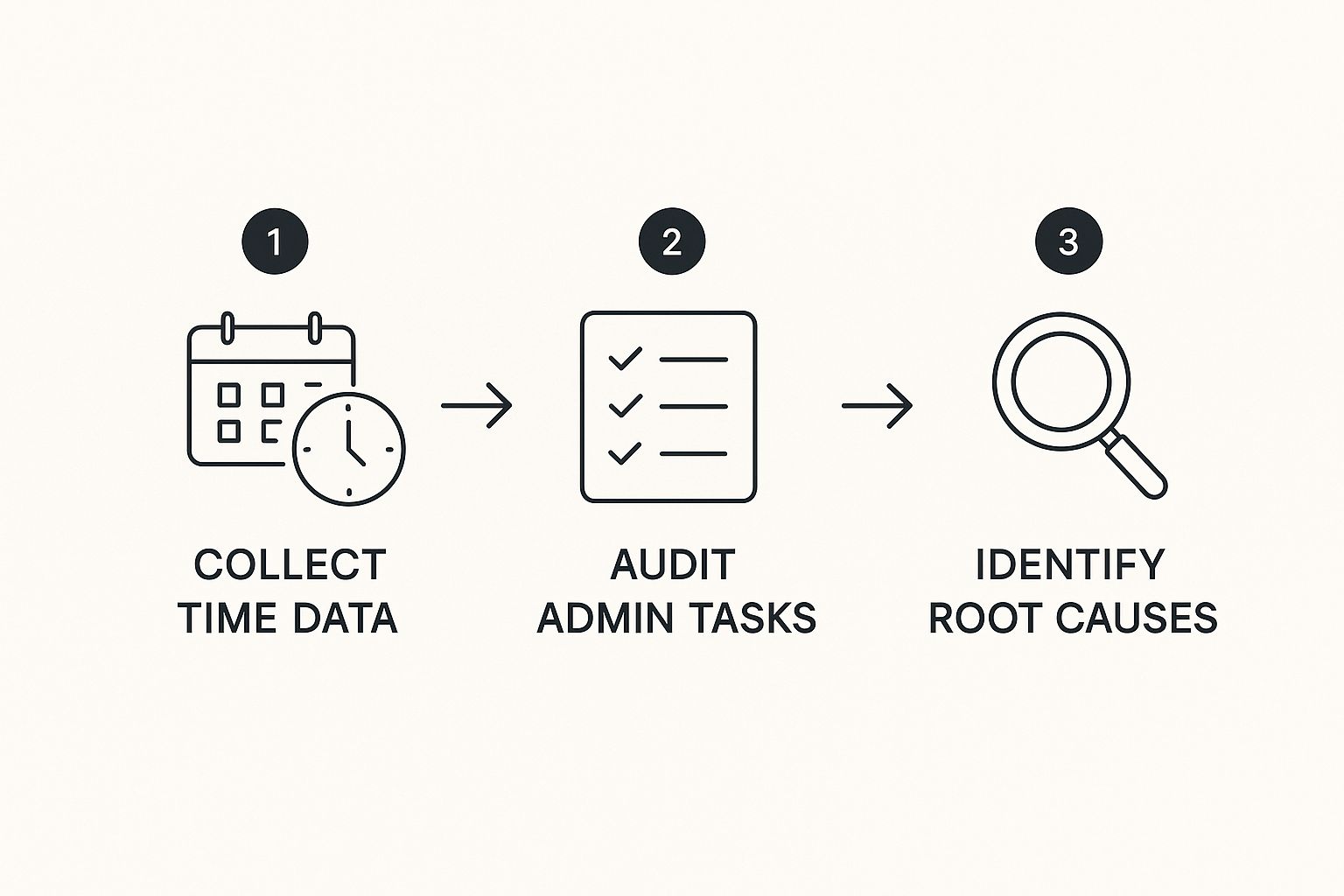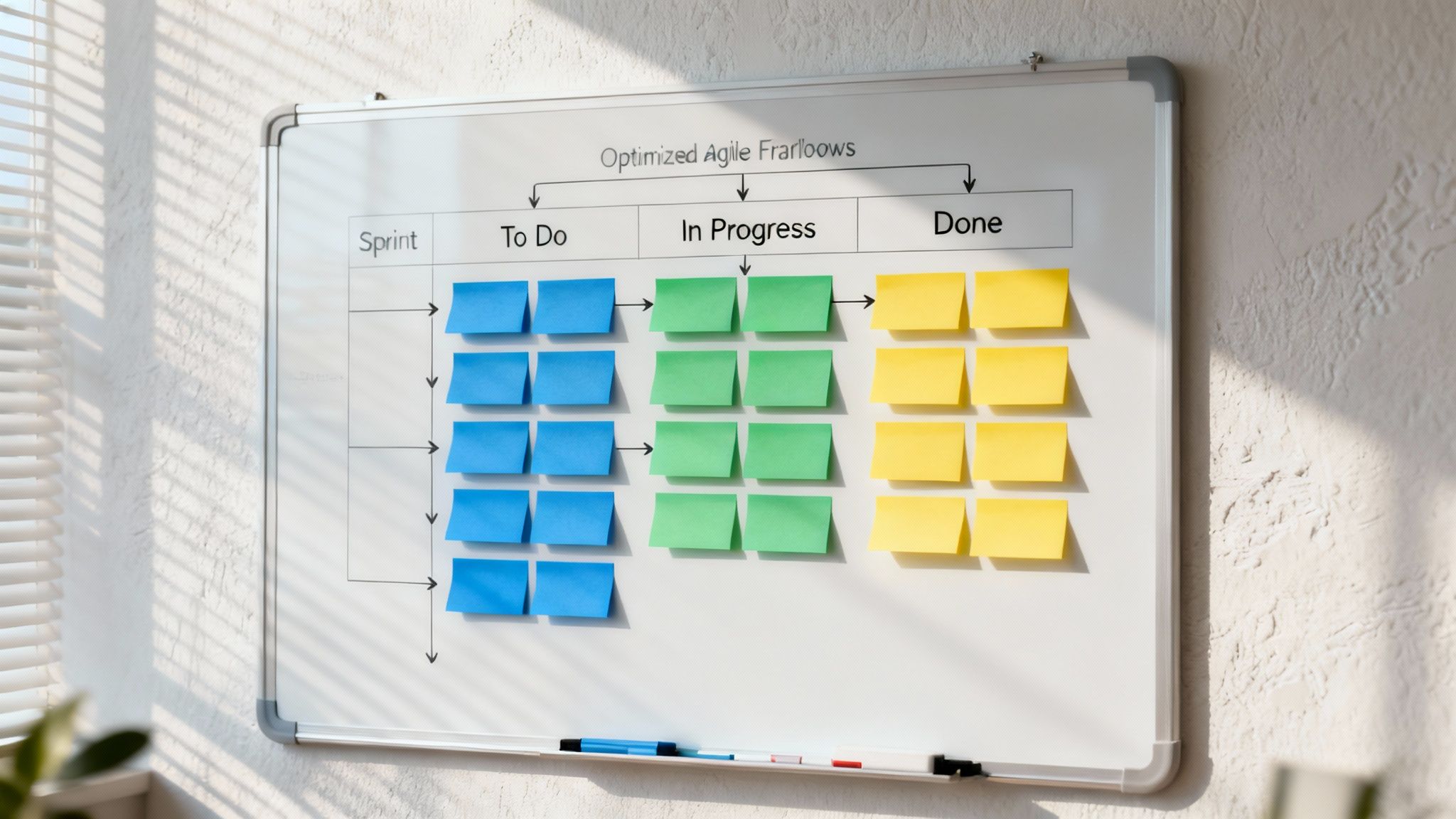When we talk about improving team efficiency, we're not talking about cracking a whip and demanding longer hours. It's about creating smarter workflows. The goal is to optimize your processes, bring in the right tech, and build a culture where communication is crystal clear. This allows your team to hit maximum output with minimal friction, moving you from just tracking hours to building a sustainable system for high performance.
What Is Team Efficiency Really About?
True team efficiency isn't just about being busy; it's about being productive. It's a measure of how well a team uses its resources—time, talent, and tools—to get to the finish line. A team can work crazy long hours and still be wildly inefficient if their efforts are getting bogged down by bottlenecks, bad communication, or tasks they have to do over and over.
On the flip side, an efficient team produces incredible work without staring down the barrel of burnout. Why? Because their workflows are clear, and everyone's pulling in the same direction. The real aim here is to create an environment where smart work is just how things get done.
The Pillars of an Efficient Team
Getting to this state of flow doesn't happen by accident. It's built on a solid foundation of a few key principles. When you start digging into how to improve team efficiency, you’re really looking at the core components of how work happens.
These foundational pillars include:
- Streamlined Processes: Think clear, repeatable workflows for common tasks. This cuts down on confusion and wasted effort right away.
- Effective Communication: Information needs to flow freely and accurately. This is how you prevent the misunderstandings and delays that kill momentum.
- Strategic Technology Use: It's about implementing tools that actually help by automating low-value work and offering critical insights, not just adding another layer of complexity.
- Supportive Culture: You need to build an environment of psychological safety and accountability. When people feel empowered, they do their best work.
An efficient system doesn't just happen; it's designed. It requires looking past surface-level symptoms like missed deadlines to diagnose the root causes, whether they're in your processes, tools, or culture.
Moving Beyond Outdated Metrics
For decades, the conversation around productivity was stuck in an industrial-era mindset: more hours equals more output. That's just not how it works anymore. Modern knowledge work requires a much more thoughtful approach that prioritizes focus and well-being over sheer time spent at a desk.
For a deeper dive into these concepts, you can find a ton of practical insights on how to improve workplace efficiency. Consider this guide your framework for making these modern principles a reality for your own team.
Find and Fix Your Team's Hidden Bottlenecks
If you want to improve your team’s efficiency, you have to put on your detective hat first. It's so tempting to jump straight to a shiny new tool or a revamped process, but let's be honest—without a proper diagnosis, you're just throwing solutions at the wall and hoping something sticks.
The real drags on your team's productivity are rarely obvious. They're usually buried just beneath the surface, disguised as everyday annoyances or "just the way things are done around here."
Get a Clear Picture of Where Time Is Really Going
Your first mission, should you choose to accept it, is to figure out where the hours are actually disappearing. It’s easy to look at a surface-level problem, like a marketing team constantly getting sidetracked by last-minute requests, and blame it on poor planning. But when you dig a little deeper, you often find the root cause is something else entirely—a broken intake process or a total lack of clear priorities coming from leadership.
The most objective place to start your investigation is with data. Your team’s calendars are a goldmine. They show you exactly how much time is being eaten up by meetings versus actual, focused work. Analyzing this data can uncover some shocking truths, like an engineering team spending a staggering 30% of their week in status updates instead of writing code.
This is where a time audit is an absolute game-changer. By systematically looking at calendar data, you can finally put hard numbers to those gut feelings you've had about inefficiency. For a detailed walkthrough, check out our guide on how to do a time audit and turn that raw data into insights you can actually use.
Uncover the Dreaded "Work About Work"
One of the biggest, most pervasive productivity killers is what's known as "work about work." This isn't the core job; it's all the stuff you have to do to do the job—hunting for information, juggling a dozen different apps, chasing down approvals. It's maddening.
It's also more common than you think. Some data suggests workers can spend around 60% of their day on these tasks, not their primary duties.
To get a handle on this, you need to look beyond the calendar and get direct feedback from your team. Ask them pointed questions like:
- How much of your day is spent just looking for documents or assets?
- Which recurring tasks feel way more complicated than they should be?
- Where are the communication black holes where things constantly get lost?
When you pair this qualitative feedback with the hard data from your time audit, you start to see the full picture. The real bottlenecks begin to emerge, clear as day.
To help you connect the dots, it’s useful to think about common symptoms and what they might be pointing to.
Common Inefficiency Symptoms and Their Root Causes
Sometimes, the problem you see isn't the real problem at all. Use this table as a starting point to diagnose what's happening under the hood.
| Symptom | Potential Root Cause | First Step to Investigate |
|---|---|---|
| Missed Deadlines | Unrealistic timelines, scope creep, resource shortages | Audit past project timelines. Are estimates consistently wrong? |
| Team Burnout | Excessive meetings, unclear priorities, uneven workload | Analyze calendar data for meeting density. Survey team on priority clarity. |
| Low-Quality Work | Lack of focus time, insufficient training, tool overload | Review calendars for fragmented schedules. Ask team about their tools. |
| Constant Fire-Drills | Poor planning, reactive vs. proactive work culture | Map out the project intake process. Where do urgent requests come from? |
This diagnostic approach helps you move beyond treating symptoms and start fixing the underlying issues that are holding your team back.
The infographic below neatly summarizes this detective work into a simple, three-part process.
As the visual shows, a systematic method of collecting data, auditing tasks, and identifying the true root causes is your best bet for making improvements that actually last. Once you've identified the patterns causing delays and draining resources, you can finally stop guessing and start designing solutions that work.
Redesign Your Workflows for Peak Performance
Once you've pinpointed where things are getting bogged down, the real work begins: building better systems from the ground up. Boosting team efficiency isn't about cracking the whip to make people work faster; it's about removing the friction that slows them down in the first place.
The goal is to redesign your workflows so the path of least resistance is also the most productive one.
Think about a common project killer: the endless email chain. A simple workflow redesign could be creating a dedicated Slack channel for project updates. This one small shift creates a single, searchable hub for communication, immediately cutting down on the time everyone wastes digging through inboxes.
Embrace Agile Principles in Any Team
You don't have to be a software developer to get huge benefits from agile methods. Core concepts like sprints and daily stand-ups can bring incredible focus and clarity to any kind of work, from marketing campaigns to financial reporting.
- Sprints: Instead of trying to tackle a massive, year-long project in one go, break the work into smaller, manageable chunks. These "sprints" typically last one to two weeks and create a steady rhythm of focused work followed by regular check-ins.
- Daily Stand-ups: A quick, 15-minute daily huddle where everyone shares what they accomplished yesterday, what they're focusing on today, and—most importantly—any roadblocks they've hit. This isn't a status report for the boss; it's a lifeline for the team to sync up and help each other out.
This approach keeps everyone on the same page and makes it much easier to pivot when priorities inevitably change. You can course-correct in days instead of waiting months to find out a project has gone completely off the rails. It's also critical to figure out which meetings need to happen live versus asynchronously. For a deep dive, you can learn more about which essential meetings can be async and which ones just can't.
The ultimate goal of any workflow redesign is to create a 'single source of truth.' Whether that's a Trello board, a shared Google Doc, or your CRM, there needs to be one central place where everyone can find the most current information. This simple rule eliminates confusion and the dreaded "version control" nightmare.
Standardize and Automate Repetitive Tasks
Every single team has tasks they do over and over again. Standardizing these processes is a massive efficiency win just waiting to be claimed. Create simple checklists or templates for recurring activities like onboarding a new client, publishing a blog post, or pulling a monthly report.
Once a process is standardized, the real magic happens: you can start looking for ways to automate parts of it.
Here’s how this plays out in the real world:
Imagine a sales team whose follow-up process is a total mess. High-value leads were slipping through the cracks simply because follow-ups were inconsistent and manually tracked in a chaotic spreadsheet.
They redesigned their workflow by:
- Establishing a Single Source of Truth: All lead information was migrated into a shared CRM. No more spreadsheets.
- Standardizing the Process: They created a clear, five-step follow-up sequence that every rep had to follow for every new lead.
- Automating Reminders: They set up automated tasks in the CRM to nudge reps when it was time for the next follow-up call or email.
The result? The team stopped wasting precious time on manual tracking and could pour that energy into actually building relationships. Their follow-up rate improved dramatically, which led directly to a higher close rate and more revenue. To take it even further, consider implementing specific strategies to boost sales productivity and fine-tune your team's output.
Use Technology and AI to Your Advantage
Technology should be an ally that frees your team up, not another distraction that bogs them down. The right tools, when you bring them in strategically, can amplify your team's output by automating the mundane stuff and serving up crucial insights. It’s less about just adding more software and more about integrating smart solutions that actually solve real problems.
Generative AI, in particular, is a game-changer for getting routine tasks off your team's plate. Imagine a content team using an AI assistant to spin up first drafts, or a support team using a chatbot to handle those initial customer questions. These tools tackle the repetitive groundwork, freeing up your team's creative and strategic brainpower for higher-value work.
Centralize and Automate for Clarity
One of the fastest ways to boost team efficiency is to tear down information silos and automate routine updates. When vital information is scattered across emails, DMs, and a dozen different documents, your team wastes precious time just hunting for what they need.
This is where centralizing your work becomes a non-negotiable. Project management tools like Asana or Trello and communication hubs like Slack are built for exactly this.
- Create a Single Source of Truth: A dedicated project board means everyone knows the real-time status of tasks, who owns what, and when deadlines are looming.
- Automate Status Updates: You can set up integrations that automatically post updates to a Slack channel when a task is done or a milestone is hit. This alone kills the need for all those "just checking in" meetings.
Of course, the key is proper implementation and training. Your team needs to understand why you're using these tools and how to use them effectively to actually see the benefits.
Let AI Handle the Heavy Lifting
Beyond basic automation, AI is becoming incredibly good at handling complex, time-sucking tasks that drain your team's focus. The impact of this shift is huge, and the numbers back it up.
We're seeing a strong link between AI adoption and productivity. A remarkable 72% of companies that lean heavily on AI report higher productivity and even improved job satisfaction. On top of that, 75% of knowledge workers say AI helps them save time, focus better, and be more creative.
Think about the tasks that currently chew up manual effort but don't really need a human touch until the final stages. You can learn more about which specific tasks are ready to be delegated to AI in our detailed guide.
From summarizing long meeting transcripts to analyzing customer feedback for key themes, AI can process massive amounts of information in seconds. It hands your team the core insights they need to act decisively. This partnership between human talent and artificial intelligence is what building a truly efficient modern team is all about.
Build a Culture of Accountability and Engagement
The slickest processes and the most advanced tools will fall flat in a disengaged or toxic environment. At the end of the day, the human element is the real engine behind your team's efficiency. When people feel valued, trusted, and psychologically safe, they don't just show up—they bring their A-game, turning good workflows into great outcomes.
This is all about creating a culture where accountability and engagement are two sides of the same coin. Accountability isn’t about pointing fingers when things go sideways; it's about fostering a genuine sense of ownership. Give your team members clear goals and help them see how their work connects to the bigger picture, and you'll see them start taking initiative and solving problems before they even hit your radar.
Set Clear Expectations with OKRs
One of the best ways to build this sense of ownership is by using a goal-setting framework like Objectives and Key Results (OKRs). OKRs give you a simple but powerful structure to get everyone pulling in the same direction.
Here's the breakdown:
- Objectives are the big, ambitious, qualitative goals you’re aiming for. Think: "Become the Go-To Resource in Our Niche."
- Key Results are the specific, measurable milestones that tell you you've hit your objective. For instance: "Increase organic blog traffic by 25%" or "Secure 5 guest post features."
This simple framework shifts the team's focus from just being busy to making a real impact. It gives everyone a clear answer to the question, "What does success actually look like for us?" That clarity is what empowers people to make smart decisions on their own, without needing constant hand-holding.
The Critical Link Between Well-being and Productivity
You can't build a high-performance culture on a foundation of burnout. Pushing for short-term gains at the expense of your team's mental health is a surefire recipe for disaster. Burnout isn’t just a personal problem; it’s a systemic threat that can completely derail even the most well-designed workflows.
The numbers paint a pretty grim picture. A shocking 32% of U.S. employees report feeling engaged at work, and a staggering 66% say they've experienced burnout. It's even worse for younger workers, with 81% of those aged 18–24 reporting burnout, which puts any hope of long-term productivity at serious risk. You can dig into more of these employee productivity statistics on high5test.com.
A culture of accountability isn't built on fear or pressure. It's built on a foundation of mutual respect, where leaders model healthy work-life boundaries and invest in their team's professional and personal growth.
What does that look like in practice? It means actively encouraging your team to disconnect after hours. It means giving regular, constructive feedback that’s focused on growth, not just criticism.
And it means investing in professional development opportunities, which sends a powerful message that you see your people as long-term assets, not just cogs in a machine. When people feel genuinely supported, they’re motivated to perform at their best. It’s as simple as that.
Common Questions About Improving Team Efficiency
Even with a solid game plan, you're bound to run into questions when you start tweaking how your team works. Here are some of the most common ones we hear from managers, along with some straight answers to help you navigate the changes.
What Is the First Step to Improve a Team's Efficiency
Before you do anything else, you have to accurately diagnose the problem. It’s incredibly tempting to jump straight to a new tool or process that promises the world, but if you don't understand the real bottlenecks, you’re just throwing spaghetti at the wall.
Start by auditing how much time gets lost to "work about work." This is all the non-essential stuff like hunting for information, chasing approvals, or sitting in redundant meetings. Use hard data from your team's calendars and, just as importantly, get direct feedback from them on their biggest roadblocks. A clear diagnosis means your solutions will actually hit the mark.
How Can I Improve Efficiency Without Micromanaging My Team
This is a big one. Improving efficiency should feel empowering, not like you're looming over everyone's shoulder. The key is to focus on outcomes, not activities.
Set clear goals and deadlines, then give your team the space to figure out the best way to get there. Your job is to clear obstacles from their path, not to watch every single move they make.
Frame these changes as a way to eliminate the frustrating, repetitive tasks that nobody likes. When you do that, they can focus on the more engaging, high-value work. This approach builds the trust and autonomy that are the real drivers of long-term performance.
True efficiency isn't about tracking every minute; it's about making every minute count. Provide your team with better tools, streamlined processes, and the autonomy to do their best work.
Are Meetings Always Bad for Team Efficiency
No, not all meetings are bad. But pointless, poorly-run meetings are a massive drain on productivity. The problem isn't the meeting itself—it's the execution. A well-run meeting is a high-leverage activity; a bad one is a productivity killer.
To make sure your meetings are actually adding value, stick to a few simple rules:
- Have a Clear Purpose: Every invite needs to state the meeting's goal and what you hope to achieve.
- Set a Strict Agenda: A tight agenda keeps the conversation focused and prevents it from spiraling.
- Invite Only Key People: If someone doesn't need to be there to contribute or make a decision, let them get back to their work.
- End with Action Items: No one should leave a meeting wondering what happens next. Conclude with clear next steps, who owns them, and by when.
And always ask yourself: "Could this meeting be an email?" Sometimes, a detailed message or a shared document is all you need.
How Does Remote or Hybrid Work Affect Team Efficiency
Remote and hybrid models can be a huge boost to efficiency. People get back their commute time and gain a lot more flexibility in how they structure their day. But, this setup absolutely requires a more deliberate and intentional approach to communication to really work.
The most effective hybrid teams rely heavily on asynchronous communication. They use project management tools, shared docs, and clear documentation to keep everyone in sync, no matter what time zone they're in. It's crucial to establish clear protocols for how and where you communicate so important information doesn't get lost in the shuffle. When you get the systems right, research shows that a hybrid model can lead to higher productivity and happier, more loyal employees.
Ready to stop guessing where your team's time is going? TimeTackle gives you the data-driven insights you need to pinpoint inefficiencies and build smarter workflows. Analyze calendar data automatically and turn it into actionable reports. See how you can improve your team's performance by visiting https://www.timetackle.com today.







